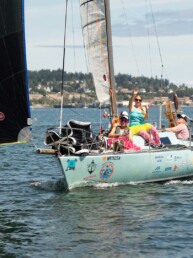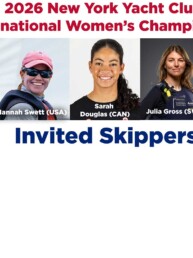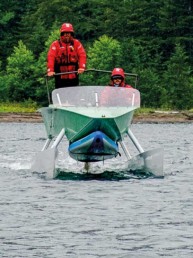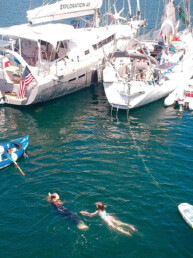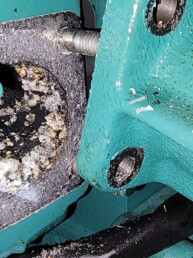In July and August, my husband Frank and I paused our summer cruising adventures in the Pacific Northwest and soon found ourselves dropping by multiple yacht clubs in the UK, where of course we were surrounded by boat talk. The English are mad about sailing. What surprised us were the people we met casually — at pubs, in museums, even on park benches — who wanted to talk about sailboat racing. “Are you here for Fastnet?” asked a random passenger on our train from Edinburgh. “Will you stay for Cowes Week?” The answer to both questions was “yes.” He was a marine engineer who overheard us talking about our plans to visit the village of Cowes on the Isle of Wight. This new friend chatted for several hours as our train sped toward London, revealing his dream of retiring on a sailboat in southern England.
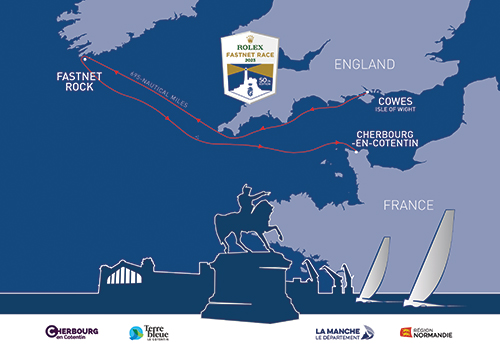
Maybe living on an island brings a pervasive awareness of the sea. Maybe the interest in boats is a holdover from England’s imperial quest to rule the high seas, which once made it the world’s greatest naval power. Maybe it’s the involvement of the Royals. Whatever the reason, the English interest in all things sailing made me see yacht racing from a new perspective.
The Fastnet Race and Cowes Week embrace historical, cultural, and social components that make them more than sporting events. Cowes has been a focal point of sailboat racing since the 1820s, and in recent decades its advantageous location has drawn a growing number of entries from far-flung corners of the globe, including the Pacific Northwest. These sailors come for the challenging racecourse and to connect with the international sailing community.
The first thing I noticed as my ferry approached Cowes was the strong wind. Our vessel wove through hundreds of sailboats tacking back and forth across the Solent, a strait separating mainland England from the Isle of Wight. No one seemed concerned, on the ferry or on the water, when a small boat went over. The sailors quickly righted their craft and continued. On shore, the wind whipped through the narrow streets, rattling the windows of waterfront restaurants and shaking the walls of our bed and breakfast with alarming force. Frank and I both lost hats. In classic British understatement, the locals described these conditions as “sporty,” “lively,” and, my favorite, “breezy.”
A Race “With Teeth”
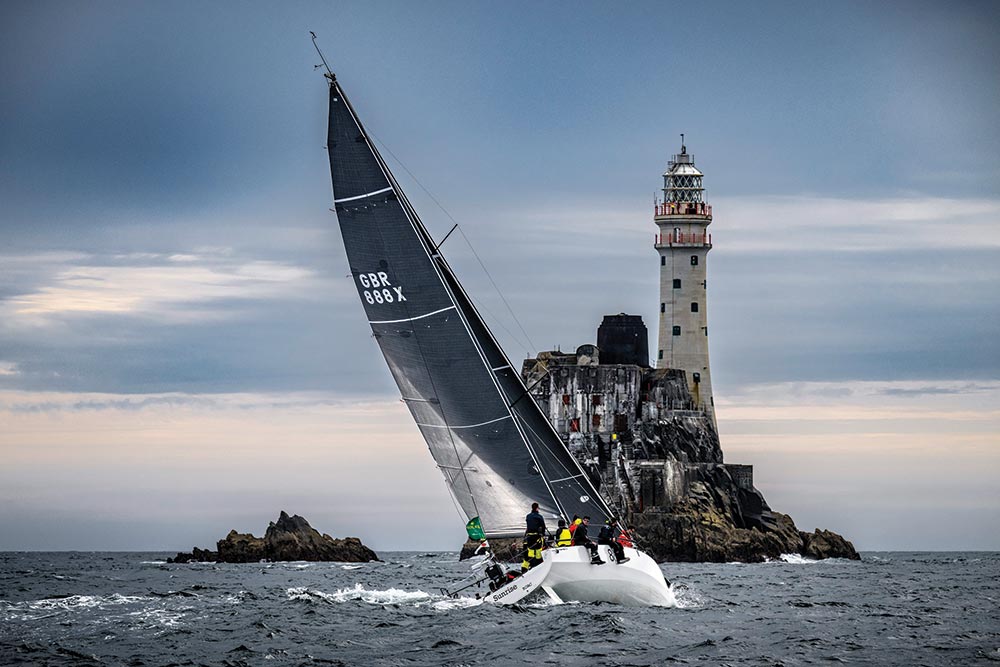
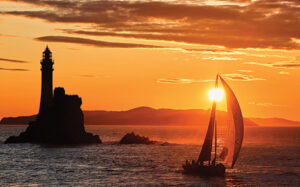
Photo credit: 2023 Rolex Fastnet Race, Carlo Borlenghi.
Fastnet is the world’s largest offshore yacht race, with a record 430 boats starting this year. The Fastnet is well known to Salish Sea sailors and is on many serious racers’ bucket lists. The event, now sponsored by Rolex, has come a long way since its first year in 1925, when only seven boats participated. The Royal Ocean Racing Club (RORC), based in London and Cowes, organizes the event biennially and 2023 marked the 50th edition. On July 22, racers set out from Cowes in a storm, facing a course of 695 nautical miles that included rounding Fastnet Rock in southern Ireland and finishing at Cherbourg-en-Cotentin on the coast of Normandy in France.
As a hardy Northwesterner, I thought I knew wind and rain. But I could barely hang on as the press boat bounced through the waves and spray to keep up with the racers. Drenched, I clung to the handles of the inflatable, watching the various classes fly past on their way into the English Channel.
The combination of innovative and traditional boats was dazzling. In a display of high-tech splendor, vessels of advanced, modern design soared by, showing off their carbon fiber masts and sails, retractable foils, dual rudders, and canting keels, while bright orange storm jibs offered a flash of color against the dreary gray of the sea. The massive 32/23 Ultim trimarans and the 60-foot foiling IMOCAs towered above the water, looming like Klingon warships.
At the same time, the traditional shapes of classic boats seemed to link this competition to earlier races. Vintage yachts included Kialoa II, a 73-foot maxi yawl that had participated in previous Fastnets and many other ocean races, such as Transpac and Sydney Hobart. “The old girl,” as owner Paddy Broughton called his boat, brought a sense of bygone eras to this Fastnet, reminding us of “all the old races… done in her time.” He did not appear too concerned about victory. “I’m looking forward to drinking good French wine in Cherbourg,” he commented at a press conference before the race.

I spotted Red Ruby, a Sun Fast 3300 owned and crewed by Pacific Northwest duo Christina and Justin Wolfe, in a stream of boats at the start. This husband and wife team from Orcas Island, who named their boat after a Salish Sea octopus, had joined a growing number of doublehanded entries in Fastnet (read their full report on the race in the October 2023 issue of 48° North). “There were 21 other Sun Fast 3300s racing,” Justin observed. “There is nowhere else in the world where you can get that.” Doublehanding is their chosen way to race, and offers a variety of challenges, including crew dynamics. “We really share,” Justin explained. “We switch over driving very frequently.” Moreover, “we have fun doing it. I actually have no interest in racing with someone else,” (James Boyd, “Doublehanded Domination at 2023 Rolex Fastnet Race,” Sail-World).
It was a similar thrill to see Ellie Driver, a 21-year-old racer on another Sun Fast 3300, Chilli Pepper, on the water. Before the race, she also commented on the importance of family closeness and doublehanding with her father. My dad and I “are quite real with each other,” she said, noting how they remain flexible, relieving each other for watches as needed, rather than following a rigid schedule. Meanwhile, her mother makes sure the boat is “fully stocked” with comfort food, including banana bread (Rolex Fastnet Race Press Conference, Cowes, July 21).
The weather deteriorated as the Fastnet fleet entered the English Channel. The Solent was in full ebb, setting up wind-against-tide conditions. During the first night, gusts of more than 40 knots created large, confused seas. The doublehanded racers aboard Vari, a Sun Fast 3600, issued a May Day call when their boat began to sink. The pair climbed into their life raft and within 15 minutes Vari was gone. Some accounts claim that one of the racers went into the water. In any case, a rescue vessel from Yarmouth on the Isle of Wight brought them safely ashore. The next morning, as my husband Frank and I left on a ferry bound for the race finish in Cherbourg, we noticed Yoyo, a Royal Naval Sailing Association boat that we had seen at the race start, in the harbor – dismasted. Yoyo was just one of many boats too damaged to continue, battered by the gales of Fastnet.
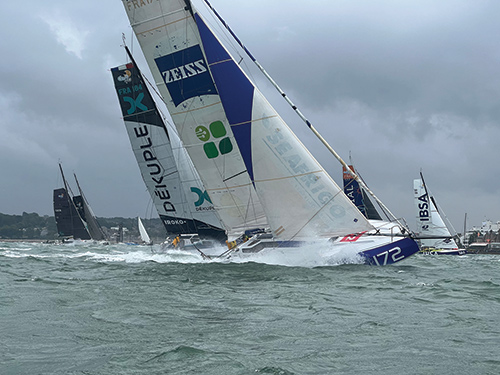
Photo credit: Lisa Mighetto.
“It was the hardest, windiest race since 1979,” commented one of the event organizers, referring to the disastrous year the Fastnet Race lost 15 sailors and four civilians in a Force 10 gale. In the decades since 1979 the event has benefitted from improvements in yacht design, weather predictions, and life-saving procedures. These were “challenging conditions” in 2023, acknowledged Steve Cole, RORC racing manager, serving as “a powerful reminder that this event may happen in mid-July but can still have teeth” (“A Worthy Rolex 50th Fastnet Race”).
Red Ruby covered more than 200 miles in the last 24 hours of the race, finishing seventh in IRC Two-Handed. France won 8 of the 12 classes, with Switzerland winning 3 and the USA taking one. The French boat SVR Lazartigue, skippered by François Gabart, was first to arrive home. Placing first in the Ultim Class, SVR Lazartigue set a multihull elapsed time record for the race: 1 day, 8 hours, 38 minutes, and 27 seconds.
While 2023 was a wild year for Fastnet, Stephanie Campbell, an Anacortes-based sailor and 48° North writer who raced Fastnet in 2021, remarked that this event is typically demanding. “You will be racing in lots of wind,” she advised potential competitors, adding that “we thought the swells were big in the Solent,” but they “only increased” in the channel. She could have been describing the 2023 race. Northwest competitors may have an advantage in that the Solent is “similar to Puget Sound” and racers here are used to big tides. She suggested that Northwest sailors interested in this event charter a boat with their own crew or jump on as part of a larger crew, as four members of the Equus team from Three Tree Point Yacht Club did on a Volvo 65 this year. England is charming and beautiful, Campbell concluded, and “full of … a genuine love for sailing” (“The Adventure We Got: PNWers Tackle the Fastnet 2021,” 48° North, September 2021).
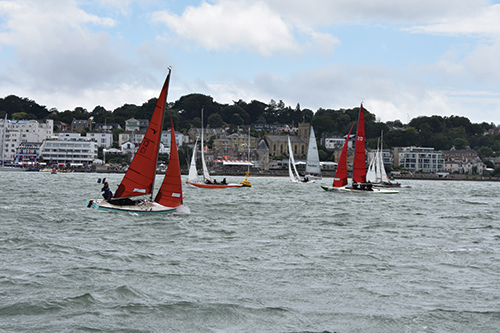
Breaking Bread at Cowes Week
When the Cowes Week regatta followed the Fastnet Race in late July, the wind-against-tide conditions persisted, producing big seas that interrupted several of the races. Even so, the frequent sound of start cannons echoed through the village, signaling that many competitions continued. Past participants in Cowes Week indicated that these conditions are not unusual. The Seattle-based crew of the 1D48, Flash, raced on a chartered Ker 40 in 2012, winning the Queen’s Cup in challenging conditions. When asked how his crew fared so well, Steve Travis replied, “Seattle has tides also!” (Steve Travis, “Flash Crew Wins Queen’s Cup at Cowes Week,” CYC, Aug. 30, 2012).
While the first regatta in 1826 included only a handful of entries, Cowes Week now attracts around 500 boats and thousands of competitors, ranging from teenagers to seniors, and from world-class competitors to ordinary sailors. The sense of tradition is strong here. Several classes that competed 50 years ago are still racing today, including Dragons, Flying Fifteens, Redwings, Sea View Mermaids, Solent Sunbeams, Swallows, and Victories.

Photo credit: Lisa Mighetto.
At Cowes Week, you come for the racing and stay for the socializing (or, as Frank puts it, “come for the carnage, stay for the cocktails”). This is nothing new. The Seattle Daily Times reported on the regatta throughout the late 19th and early 20th centuries, focusing as much on the highbrow parties as on the races. Hoping to elevate her position in New York society, for instance, Mrs. George Gould visited Cowes Week in 1899, “taking tea” on a yacht with the Prince of Wales in the “happiest event in her recent social career” (Seattle Daily Times, August 12, 1899). Cowes Week, another article explained, marked the end of the social season in England, where “the flower of British aristocracy throngs the little town, so it is almost impossible for servants to keep track of the constant going and coming of visitors from one house to another” (Seattle Daily Times, Oct. 31, 1926).
In my experience, which was more humble, the village took on a festival atmosphere, where you could hear sea shanties on one street corner and live rock music on the next. Colorful banners lined the streets, flapping in the wind above ice cream carts and booths of nautical merchandise. Cocktail parties brought racers together with fans and spectators, all discussing regattas past and present. “It was on my bucket list,” was a common response when I asked racers what drew them here. As one member of the Royal Thames Yacht Club suggested to me, “England is sailing-mad” and “Cowes is the center.” He had raced three Fastnets and had participated in more Cowes Weeks than he could recall.
Occasionally, the rain and wind drove people into the pubs and restaurants along the waterfront. Here, too, everyone seemed eager to share their race stories, which flowed freely in this relaxed setting. “We come to Cowes to meet up with friends we see once a year,” one sailor informed me, bringing to mind sentiments from big events in the Pacific Northwest like Race Week or Swiftsure. This international crowd looked to fellow patrons in navigating the menus. Frank loved the cask ales, recommending favorites to those sampling them for the first time. Similarly, racers and spectators bonded over exploring regional cuisine. While beef and ale pie appeared to be a straightforward meal, what, exactly, is a Toad in the Hole? And for dessert: a honeycomb doughnut, Eaton mess, or spotted dick (yes, you read that correctly). I drew the line at an “oozing toastie,” not wanting to eat anything that “oozed.” But one Scottish sailor encouraged me with a charming phrase. “Give it’ a wee go,” he urged. Sounds like words to live by – for trying out unfamiliar food and sailboat races.
Surely, with their storied tradition and massive turnout, both Fastnet and Cowes will draw Salish Sea sailors in future years; what the sailing-mad Brits might not realize, however, is how much fun they’d have joining a big regatta on our local waters.
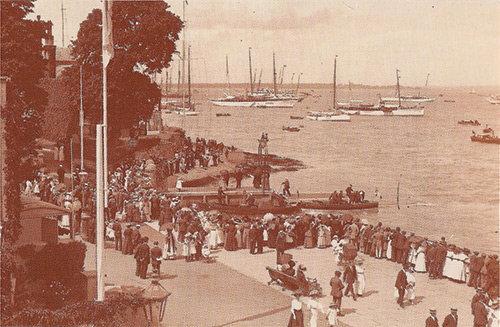
Lisa Mighetto is a sailor and historian living in Seattle. The author is grateful for use of the libraries at the Royal Thames Yacht Club, London, and the Cowes Maritime Museum. Her reflections on the UK sailing community also appear in “Bash to the Rock,” Sailing Magazine (October 2023).

